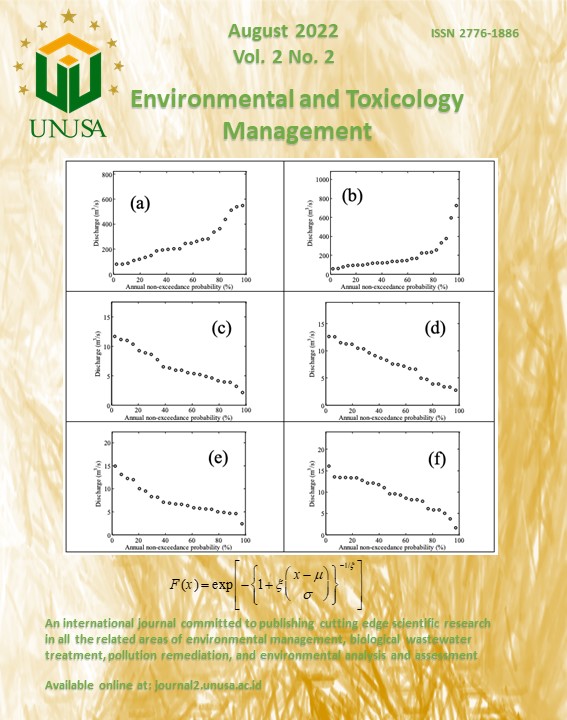Hydrology method for environmental flows assessment of Johor River Basin under regulated and non-regulated conditions
##plugins.themes.bootstrap3.article.main##
Abstract
This paper evaluates the capability of hydrology method for environmental flow (Eflow) assessment of Johor river basin under non-regulated and regulated conditions due to dam construction. Daily river flow data from 1971 to 2017 was used for the assessment. Generalized extreme value distribution was applied in order to estimate exceedance probabilities associated with historical observation data at different return periods. Environmental water allocations of the river at different ecological conditions were estimated using the intra-annual and inter-annual flows. This study has estimated the hydrological yearly conditions (very dry, dry, average and wet) for the river basin. Moreover, the method has also successfully proposed the environmental water allocations to achieve the desired ecological conditions, which are very good ecological (Eflow class A), good ecological (Eflow class B), medium ecological (Eflow class C), and deficient ecological conditions (Eflow class D). In general, the proposed method has been capable and acceptable for the assessment of Eflow of Johor river basin in line with sustainable water management goal.
Downloads
##plugins.themes.bootstrap3.article.details##
Copyright (c) 2022 Noor Hisham Ab Ghani, Zulkifli Yusop, Mohd Zaki Mat Amin, Thian Siaw Yin

This work is licensed under a Creative Commons Attribution-ShareAlike 4.0 International License.
References
Arthington, A. H., Kennen, J. G., Stein, E. D. andWebb, J. A., 2018. Recent advances in environmental flows science and water management—Innovation in the Anthropocene. Freshw. Biol. 63, 1022-1034 DOI: https://doi.org/10.1111/fwb.13108
Bassi, N., Kumar, M. D., Sharma, A. and Pardha-Saradhi, P., 2014. Status of wetlands in India: A review of extent, ecosystem
benefits, threats and management strategies J. Hydrol. Reg. Stud. 2, 1-19
Crespo, D., Albiac, J., Kahil, T., Esteban, E. and Baccour, S., 2019. Tradeoffs between water uses and environmental flows: A hydroeconomic analysis in the Ebro basin. Water Resour. Manag. 33, 2301-2317 DOI: https://doi.org/10.1007/s11269-019-02254-3
Hough, I. M.,Warren, P. H. and Shucksmith, J. D., 2019. Designing an environmental flow framework for impounded river systems
through modelling of invertebrate habitat quality. Ecol. Indic. 106, 105445 DOI: https://doi.org/10.1016/j.ecolind.2019.105445
Lani, N. H. M., Syafiuddin, A., Yusop, Z., Adam, U. B. and Amin, M. Z. B. M., 2018a. Performance of small and large scales rainwater
harvesting systems in commercial buildings under different reliability and future water tariff scenarios. Sci. Total Environ. 636, 1171-1179 DOI: https://doi.org/10.1016/j.scitotenv.2018.04.418
Lani, N. H. M., Yusop, Z. and Syafiuddin, A., 2018b. A review of rainwater harvesting in Malaysia: Prospects and challenges. Water. 10, 1-21 DOI: https://doi.org/10.3390/w10040506
Sabzi, H. Z., Rezapour, S., Fovargue, R.,Moreno, H. and Neeson, T. M., 2019. Strategic allocation of water conservation incentives to balance environmental flows and societal outcomes. Ecol. Eng. 127, 160-169 DOI: https://doi.org/10.1016/j.ecoleng.2018.11.005
Shuster,W. D., Bonta, J., Thurston, H.,Warnemuende, E. and Smith, D. R., 2005. Impacts of impervious surface on watershed hydrology: A review. UrbanWater J. 2, 263-275 DOI: https://doi.org/10.1080/15730620500386529
Tachamo Shah, R. D., Sharma, S. and Bharati, L., 2020. Water diversion induced changes in aquatic biodiversity in monsoon dominated rivers of Western Himalayas in Nepal: Implications for environmental flows. Ecol. Indic. 108, 105735 DOI: https://doi.org/10.1016/j.ecolind.2019.105735
VanNiekerk, L., Taljaard, S., Adams, J. B., Lamberth, S. J.,Huizinga, P., Turpie, J. K. and Wooldridge, T. H., 2019. An environmental
flow determination method for integrating multiple-scale ecohydrological and complex ecosystem processes in estuaries. Sci. Total Environ. 656, 482-494 DOI: https://doi.org/10.1016/j.scitotenv.2018.11.276





